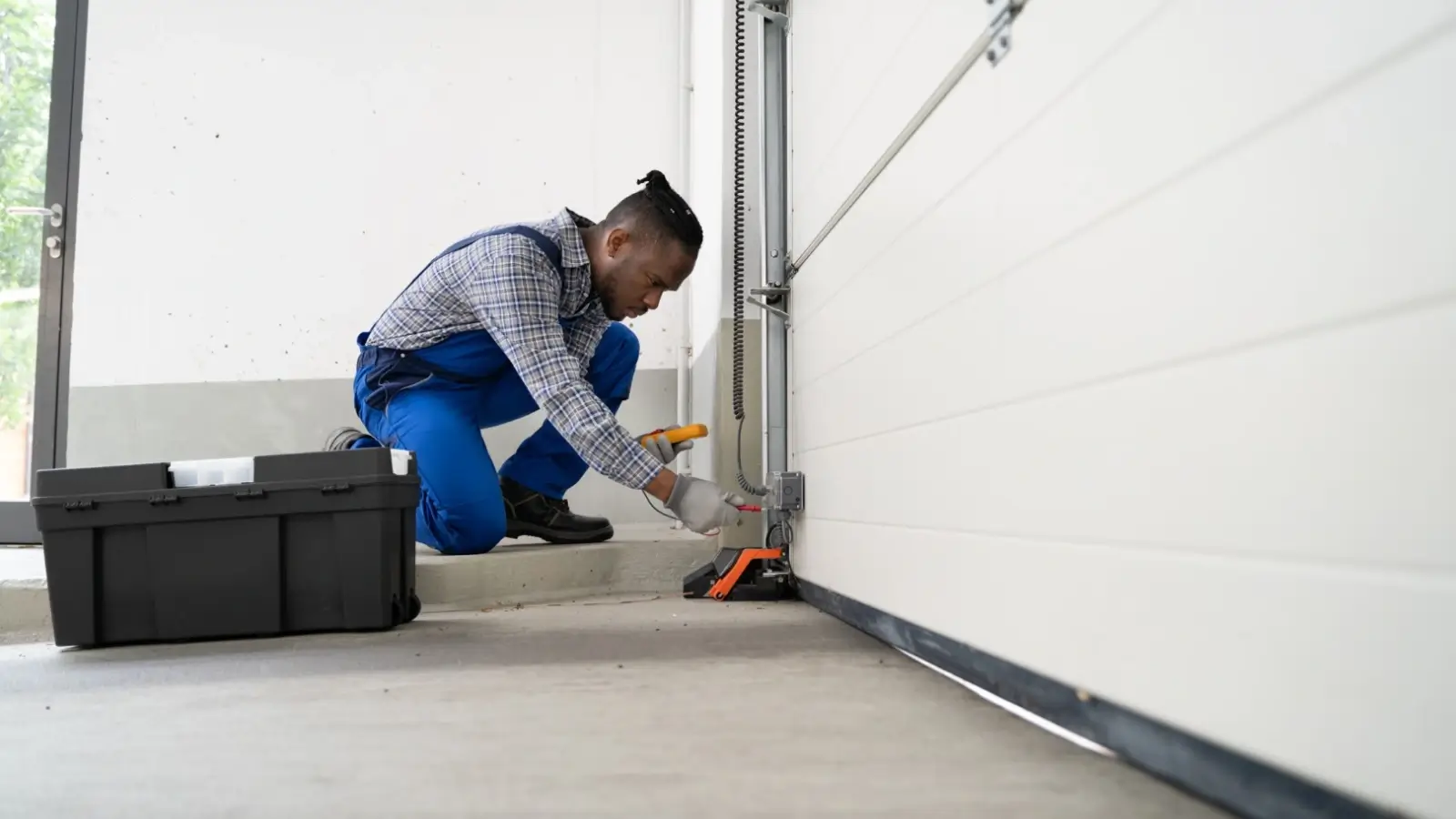


Installing a new garage door transforms both the functionality and appearance of your home. Whether you're building new construction or replacing an existing system, understanding the installation process helps ensure successful results that provide years of reliable service.
Professional garage door installation involves precise measurements, proper component selection, and expert setup techniques that affect everything from daily operation to long-term durability. The complexity of modern garage door systems—with their springs, tracks, motors, and safety features—requires specialized knowledge and tools that most homeowners don't possess.
This comprehensive guide walks you through every aspect of garage door installation, from initial planning through final testing. You'll learn what to expect during the process, how to choose the right components for your needs, and why professional installation protects your investment while ensuring family safety.
Successful garage door installation begins with thorough planning and accurate assessment of your specific requirements. The opening dimensions, ceiling height, and available space around the garage determine which door styles and operating systems will work in your situation.
Professional installers measure the rough opening width and height precisely, accounting for any irregularities in framing or foundation settling. These measurements determine track placement, spring selection, and motor positioning. Even minor measurement errors can cause operational problems or require expensive modifications later.
Electrical requirements also need evaluation before installation begins. Garage door openers require dedicated circuits with proper grounding and GFCI protection. If your garage lacks adequate electrical service, upgrades may be necessary before installation can proceed.
The condition of existing framing, walls, and ceiling structures affects installation complexity and costs. Older homes may require reinforcement or modification to support modern garage door systems safely. BOS garage door repair specialists assess these structural requirements during initial consultations.
Modern garage doors offer numerous options for materials, insulation, colors, and operating mechanisms. Understanding these choices helps you select components that meet your specific needs while staying within budget constraints.
Steel garage doors provide excellent durability and security at moderate costs. They resist weather damage, require minimal maintenance, and offer good insulation options. Aluminum doors cost less but provide reduced strength and insulation capabilities.
Wood garage doors create beautiful, traditional appearances but require regular maintenance to prevent warping, rot, and pest damage. Composite materials combine wood's appearance with improved durability and reduced maintenance requirements.
Insulated garage doors significantly improve energy efficiency, especially for attached garages. Single-layer doors provide basic functionality at lower costs, while double and triple-layer construction offers superior insulation and reduced noise levels.
R-value ratings indicate insulation effectiveness, with higher numbers providing better thermal performance. Climate conditions and garage usage patterns help determine appropriate insulation levels for your situation.
Chain-drive openers cost less initially but create more noise during operation. Belt-drive systems operate quietly but require higher upfront investment. Direct-drive motors offer the quietest operation with minimal maintenance requirements.
Horsepower ratings must match your door's size and weight. Undersized motors wear out quickly, while oversized units waste energy and may damage door components through excessive force.
Professional garage door installation follows systematic procedures that ensure proper setup, safety compliance, and optimal performance. Understanding this process helps homeowners prepare and recognize quality workmanship.
Installers begin by protecting surrounding areas and removing old door systems if necessary. Proper disposal of old materials includes recycling metal components and safely handling springs under tension.
Track installation requires precise positioning and secure mounting to support the door's weight during operation. Horizontal and vertical tracks must align perfectly to prevent binding, excessive wear, and premature failure.
Garage door springs store and release energy that counterbalances the door's weight. Extension springs work along horizontal tracks, while torsion springs operate from a shaft above the opening. Torsion systems provide smoother operation and longer life but require professional installation due to extreme spring tension.
Proper spring selection depends on door weight, size, and usage patterns. Incorrectly sized springs cause operational problems and safety hazards. Professional installers calculate spring requirements precisely and use specialized tools for safe installation.
Garage door opener installation involves mounting the motor unit, installing the rail system, and connecting the drive mechanisms. Chain, belt, or screw-drive systems each require specific installation techniques and adjustments.
Safety features, including photo-eye sensors, auto-reverse mechanisms, and manual release systems, must be installed and tested according to manufacturer specifications. These systems prevent accidents and ensure compliance with current safety standards.
Professional installation includes comprehensive testing of all operational and safety systems. Door balance, opening and closing speeds, and limit switches require precise adjustment for optimal performance.
Force settings prevent the door from exerting excessive pressure that could cause injury or property damage. These adjustments ensure the door stops or reverses when meeting resistance during operation.
Garage door installation involves significant safety considerations due to high spring tension, electrical connections, and heavy moving components. Professional installers understand current building codes and safety requirements that protect families and property.
Garage door opener circuits require GFCI protection and proper grounding according to local electrical codes. Extension cords should never be used for permanent installations, and all wiring must be properly secured and protected from damage.
Emergency disconnect switches allow manual operation during power outages and provide safety shutoffs during maintenance. These switches must be easily accessible but protected from accidental activation.
Garage door springs operate under extreme tension that can cause serious injury or death if handled improperly. Professional installers use specialized tools and techniques to safely install, adjust, and maintain spring systems.
Homeowners should never attempt spring adjustments or replacement. Even seemingly simple adjustments can release dangerous amounts of stored energy without warning.
Proper maintenance extends garage door life while ensuring continued safe operation. Professional installation includes instruction on basic maintenance procedures and schedules for ongoing care.
Monthly visual inspections help identify problems before they cause failures or safety issues. Check springs, cables, rollers, and tracks for signs of wear, damage, or misalignment.
Moving components require regular lubrication with appropriate garage door lubricants. Over-lubrication attracts dirt and debris that accelerate wear, while insufficient lubrication causes premature component failure.
Test photo-eye sensors and auto-reverse mechanisms monthly to ensure proper operation. Place objects in the door's path and verify that safety systems stop or reverse door movement appropriately.
Emergency release mechanisms should operate smoothly and allow manual door operation during power outages. Test these systems periodically, but avoid unnecessary use that could cause wear or adjustment problems.
Professional garage door installation provides numerous advantages over DIY attempts or cut-rate installation services. Quality installation protects your investment while ensuring years of reliable, safe operation.
Warranty coverage typically requires professional installation by certified technicians. Attempting DIY installation or using unqualified installers can void manufacturer warranties and leave you responsible for repair costs.
BOS garage doors repair offers comprehensive installation services with experienced technicians who understand local building codes, safety requirements, and manufacturer specifications. Their professional approach ensures proper setup while providing ongoing support for maintenance and service needs.
Professional Garage Door Installation transforms your home's functionality, security, and curb appeal while providing years of reliable service. The complexity of modern systems requires specialized knowledge, tools, and experience that professional installers bring to every project.
Don't compromise on safety or quality with your garage door installation. Contact BOS garage doors repair today to schedule your consultation and receive expert recommendations for your specific needs. Their experienced team ensures proper installation that meets all safety standards while maximizing your investment in this important home improvement project.